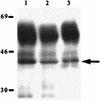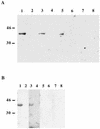Function and protective capacity of Treponema pallidum subsp. pallidum glycerophosphodiester phosphodiesterase
- PMID: 9826352
- PMCID: PMC108728
- DOI: 10.1128/IAI.66.12.5763-5770.1998
Function and protective capacity of Treponema pallidum subsp. pallidum glycerophosphodiester phosphodiesterase
Abstract
Infectious syphilis, caused by the spirochete bacterium Treponema pallidum subsp. pallidum, remains a public health concern worldwide. The immune-response evasion mechanisms employed by T. pallidum are poorly understood, and prior attempts to identify immunoprotective antigens for subsequent vaccine design have been unsuccessful. Previous investigations conducted in our laboratory identified the T. pallidum glycerophosphodiester phosphodiesterase as a potential immunoprotective antigen by using a differential immunologic expression library screen. In studies reported here, heterologous expression of the T. pallidum glycerophosphodiester phosphodiesterase in Escherichia coli yielded a full-length, enzymatically active protein. Characterization of the recombinant molecule showed it to be bifunctional, in that it exhibited specific binding to human immunoglobulin A (IgA), IgD, and IgG in addition to possessing enzymatic activity. IgG fractionation studies revealed specific binding of the recombinant enzyme to the Fc fragment of human IgG, a characteristic that may play a role in enabling the syphilis spirochete to evade the host immune response. In further investigations, immunization with the recombinant enzyme significantly protected rabbits from subsequent T. pallidum challenge, altering lesion development at the sites of challenge. In all cases, animals immunized with the recombinant molecule developed atypical pale, flat, slightly indurated, and nonulcerative reactions at the challenge sites that resolved before lesions appeared in the control animals. Although protection in the immunized rabbits was incomplete, as demonstrated by the presence of T. pallidum in the rabbit infectivity test, glycerophosphodiester phosphodiesterase nevertheless represents a significantly immunoprotective T. pallidum antigen and thus may be useful for inclusion in an antigen cocktail vaccine for syphilis.
Figures





References
-
- Baker-Zander S A, Hook E W, Bonin P, Handsfield H H, Lukehart S A. Antigens of Treponema pallidum recognized by IgG and IgM antibodies during syphilis infection in humans. J Infect Dis. 1985;151:264–272. - PubMed
-
- Baker-Zander S A, Lukehart S A. Macrophage-mediated killing of opsonized Treponema pallidum. J Infect Dis. 1992;165:69–74. - PubMed
Publication types
MeSH terms
Substances
Grants and funding
LinkOut - more resources
Full Text Sources
Other Literature Sources
Medical
Miscellaneous


